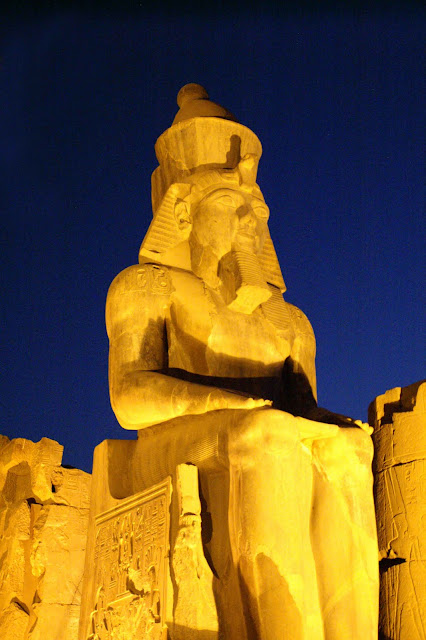If there was ever a place in all of Egypt where the ancient civilization comes to life it is in Luxor, with its countless temples, ancient monuments and the Valley of the Kings. This city on the Nile was the capital of Egypt’s ancient rulers for over five hundred years starting in 1550 BC and home of many wonders of the Egyptian Pharaohs.
Maphew at Valley of the Kings
Our discovery of Luxor began with a journey to the famed Valley of the Kings, a barren wasteland located in an enclosed valley in the Theban Hills. Here the ancient rulers Egypt built massive hidden underground tombs in an attempt to stop robbers from stealing their possessions that they needed to take to the other world. Here we visited the tombs of Queen Tawert/Sethnakt, Siptah and Ramses I, each uniquely built into the sandstone mountain with intricate (still in color) paintings and carvings on all the surfaces depicting the lives of these great leaders. The highlight was visiting the tomb of King Tut (Tutankhamum) where the famous King Tut treasures where found intact. To Laurence’s dismay however pictures were not allowed in the tombs or even in the valley, so it’s only our memories of this place we take with us and share.
Natural Pyramid in Valley of Kings
Howard Carter House, man that found King Tut
Next we visited the amazing Hatshepsut Temple dedicated to the Queen Hatshepsut (pronounced Hat-Cheap-Suit) built in 18th Dynasty. This stunning temple with its unique designs of three layers and ramps sits at the foot of a sheer limestone cliff. Here you find large imposing statures of Hatshepsut guarding the entrance to the temple with wonderful carvings and paintings on the sandstone walls.
Amazing Hatshepsut Temple dedicated to the Queen Hatshepsut
Queen Hatshepsut
If someone calls u a cow your consider very beautiful notice the cow ears
Our Group at Queen Hatshepsut Temple
Colossi of Memnon
In evening we explored the large Temple of Luxor, located on the banks of the river Nile in the centre of the modern city. Viewing a temple at nights brings on new images and sights, even adding an air of mystique to the huge monuments. At the entrance to the temple is the incredible avenue of Sphinxes, a street connecting Luxor to the much larger Temple of Karnak with countless sphinx sculptures facing the two kilometre long walk way. The main temple of Luxor was under sand silt until 1881 and therefore is in great condition. Guarding the entrance are two colossi of Ramses seated as well of one of the remaining two obelisks made out of a single piece of pink granite. In fact the second obelisk is now in Paris in the Place de la Concorde, a gift to France in the early 1900s. Behind the pylon entrance you found several temples and courtyards with massive pillars and wonderful renderings on the walls.

Then early the next morning Etienne and Laurence rose before sunset and went for a balloon ride over the Nile and the lush green valley of Luxor. They both were a bit intimated at first but enjoyed the wonderful landscape of the valley and temples from the air. The contrast from the dessert landscape meeting the lush green valley and the blue of the Nile all within only miles is a sight to see.
No trip to the Luxor area would be complete without visiting the largest of all the temples that of Karnak. This immense temple complex actually consists of several temples with its countless courts, halls, sculptures and pillars. At one point in its construction over 80,000 men laboured to build the massive complex, which lay buried under the sand for over 1000 years. At the entrance is the row of ram inspired sphinxes that lead to the large pylon style entrances. But most impressive is the Great Hypostyle Hall with its 134 gigantic columns, each intricately carved with scenes of the gods. The site also has two large obelisks intact, wonderful painted scenes in full colour and the sacred Lake. The ancient Egyptians built with great style and scale.
Entrance at Karnak Temple
It was here that our tour guide took us out for an evening to enjoy local life in the city of Luxor his home. So we took a local bus, which is a small van filled with people to the market the locals attend not the tourist market. Here we strolled by countless small shops, butcher shops, cafes down a dirt road filled with people, children, horse carts and motorcycles. He we had a sheesha at a local bar and relaxed while watching the goats play only feet away from us and watched daily life in Egypt go on before us.
Luxor truly is an amazing city, the temples, the Nile and the people will always bring us great memories of this journey.






















































Just stunning! I love to read and see the photos!
ReplyDeleteRamona
Burlington ON Canada